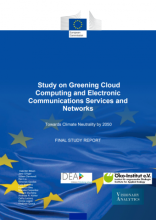The study seeks to better understand and put forward measures towards achieving the Digital Strategy goal of “climate neutral and highly energy efficient data centres and electronic communication networks and services by 2030”
The current digital transformation is characterized by a steep increase in the amount of data being generated, processed, stored, and transmitted. This has consequences on our energy consumption. In 2018, data centres accounted for 2.7% of the EU’s energy consumption. If left unchecked, this could rise to 3.2% by 2030.
This study proposes policy measures that enhance energy efficiency and circular economy practices in the ICT value chains. It focuses on cloud computing and data centres, and electronic communications services and networks.
On data centres and cloud computing the study proposes the following concrete policy measures:
- Improvements to the Code of Conduct on energy efficient data centres;
- Strengthen green public procurement criteria for data centres, server rooms and cloud services; and
- Setting up a European Data Centre Registry.
In addition, it offers a definition of what constitutes a data centre and indicators to measure progress towards meeting the 2030 objective.
Regarding electronic communications networks and services, the study proposes the introduction of an energy efficiency–type of label for telecommunications services in order to provide greater transparency to businesses and consumers. In addition, the study proposes that telecom operators record the energy intensity of the network in a central or national register, offering an overview of the different providers and the efficiency of the different network technologies. This would need to be supplemented with minimum efficiency requirements for new infrastructure and Ecodesign criteria.
These findings will feed into a number of ongoing and future initiatives linked to the Green and Digital transitions.
The study can be found in the attachment:
| Attachment | Size |
|---|---|
| Study Towards Climate Neutrality by 2050 | 7.08 MB |

